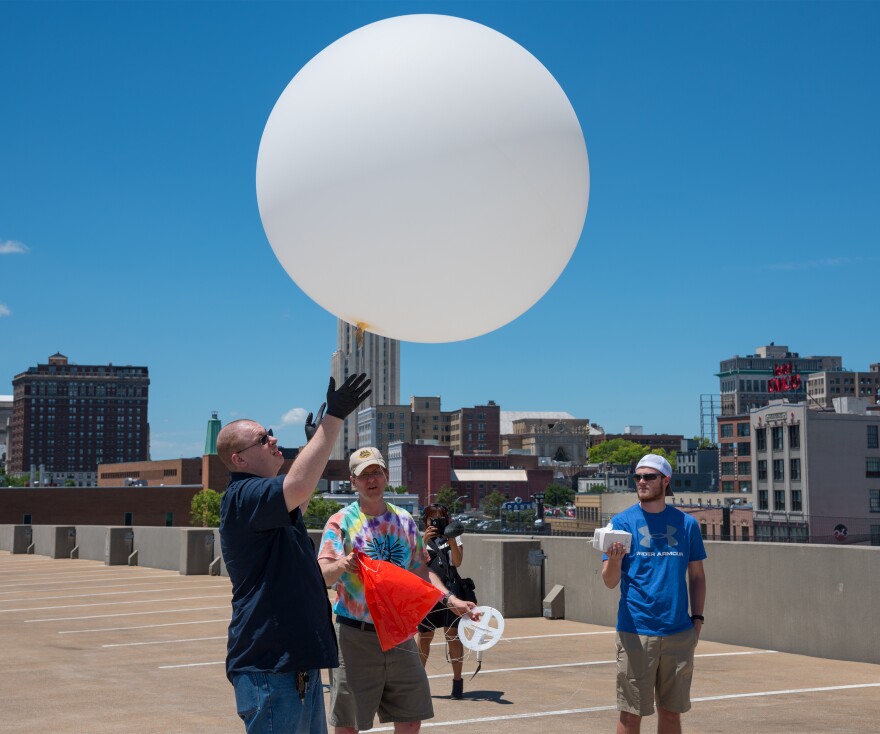Historically, total solar eclipses have been used to make important scientific discoveries. One in 1919 validated Albert Einstein’s theory of relativity. Another in 1868 led to the discovery of helium, the second most common element on the planet.
While total solar eclipses have been seen around the world a few times in the last decade, it’s pretty rare for one to be visible over large, populated areas, such as the United States. Today, scientists are taking advantage of the opportunity to run experiments that address questions about Earth and the sun that only total solar eclipses can help answer.
Many of the projects encourage participation from nonscientists who plan to observe the eclipse in the path of totality, the area where people will see the moon completely cover the sun.
“Everyone is a scientist at heart,” said Margaret Hill, a physics professor at Southeast Missouri State University. “When you look at totality or you look at the eclipse, there are many ways to observe it.”
What can the eclipse tell us about the sun?
Hill is in charge of one of 68 telescopes involved in the Continental-America Telescopic Eclipse project. Dubbed Citizen CATE, it has recruited people along the path of totality operate telescopes with cameras to capture images of the corona, which is the outer atmosphere of the sun. It can only be seen during total solar eclipses.

There’s a lot that scientists don’t know about the sun, said Angela Speck, an astrophysicist at the University of Missouri-Columbia.
“For instance, the surface of the sun is 10,000 degrees Fahrenheit,” Speck said, “which sounds hot until you realize that the corona is two million degrees Fahrenheit. So understanding how you get enough energy from the sun to heat the gas up and what mechanism causes that to happen is kind of important.”
Citizen CATE will stitch together the images taken by the cameras attached to the telescopes to create a 90- minute video of the corona.
How will the atmosphere change?
Another project will observe changes in Earth’s atmosphere that occur during the total solar eclipse. St. Louis is one of 30 sites across the country that will be participating in NASA’s Eclipse Ballooning Project.

Twice this summer, Robert Pasken, a meteorology professor at Saint Louis University, practiced launching a weather monitoring device, called a radiosonde, that measures conditions such as wind speed, humidity and barometric pressure. Pasken and his students plan to launch their weather balloon five minutes before totality happens.
“We [will] get a very nice, rapid snapshot of what’s happening in the atmosphere in this cycle that’s going to occur because of the eclipse,” Pasken said.

Pasken said that the data from the radiosondes and Ameren Missouri’s network of weather monitoring stations could help provide short-term wind forecasts in small geographic areas, such as within subdivisions and towns. He plans to use that information to help Ameren prepare for potential wind damage to power lines, poles and towers.
He also wants to study shadow bands, mysterious light and dark lines that appear on the ground a minute before and after total solar eclipses.
“Why do those shadow bands form?” Pasken said. “Do they form down low, close to the ground, like a thousand feet? Or are they much higher up like 30- or 40,000 feet?”
One way to see shadow bands is by placing a white sheet on the ground on the path of totality. Pasken encourages observers to photograph them to help scientists understand why they exist.
How will animals react?
Scientists also want to know how animals behave during solar eclipses. Researchers have speculated that they might behave the way they do at night. For example, birds may return to their nest to roost and farm animals may retreat into the barn. There is little research on animal behavior during total solar eclipses.

The California Academy of Sciences is encouraging the public to participate in a project called Life Responds, in which they log what they see animals and plants doing during the eclipse into an app called iNaturalist.
Locally, scientists at Webster University and Mizzou are setting up recording devices around Missouri to see how the sounds of bees and other insects change due to changes in light caused by the eclipse.
“They can sense changes in the electromagnetic waves that are associated with the light,” said Nicole Miller-Struttman, a pollinator biologist at Webster University. “[The eclipse] might look quite different to them than a twilight.”
How you can be a citizen scientist during the eclipse
- Send NASA images of the sky using the Observer app
- Provide the California Academy of Sciences notes about animals and plants using the iNaturalist app
- Put a white sheet down on the ground to observe the shadow bands that appear a minute before and after totality
Follow Eli on Twitter: @StoriesByEli


